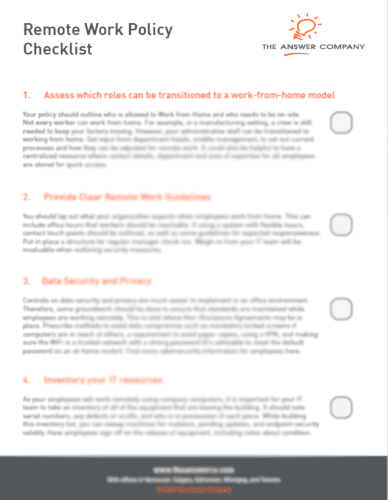We’re currently facing a new normal, one where remote work is not only preferred but is a powerful tool for stopping the spread of the novel coronavirus. For many teams, working from home is a rarity. Business owners, then, need to adapt to help their employees stay effective and productive when working remotely.
Here are some things to consider, going forward:
- Establish a Remote Workforce Policy that outlines clearly what the organization expects from remote employees and any measures that come with that. More on this below.
- Increase Remote IT Tech support access for employees that are having difficulties.
- Document new digital processes that have surfaced due to remote workforces.
- Develop paperless processes:
- Document management solutions help to store and share documents safely;
- Use EDI solutions for invoicing and purchase orders;
- Improve cash flow by implementing Electronic funds transfer (EFT) or credit card processing; and
- Identify other paper processes that can be digitized such as pick lists and work orders.
Remote Work Policy ChecklistDownload our remote work policy checklist to ensure secure and smooth operations for a work-from-home model. |
 |
Standardize Remote Employee Communication and Collaboration Tools
The sharing of information is vital to any organization. Remote working doesn’t need to halt collaboration. Corporate collaboration platforms allow employees to work together seamlessly and video conferencing helps maintain relationships.
It is important that businesses standardize by selecting a corporate platform and that employees avoid using personal collaboration platforms for security reasons.
General considerations to consider when selecting a corporate collaboration platform:
- The platform should be available over the internet and support different devices.
- Select a platform that includes Instant Messaging, Voice over Internet Protocol (VoIP) and video capabilities.
- It should integrate with other cloud-based applications such as file shares, office suites, CRM, and Project Management applications.
The Google Suite and Microsoft Teams are both built with communication and collaboration in mind. They include collaborative tools like shared documents and instant messaging services. Slack is another well-loved instant messaging service.
